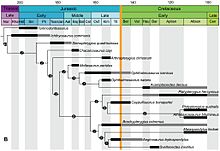User:Hekaiyo/sandbox

A ghost lineage is a phylogenetic lineage that is inferred to exist (inferred-existence) but has no fossil record.[1] The process of determining a ghost lineage relies on fossilized evidence before and after the hypothetical existence of the lineage and extrapolating relationships between organisms based on phylogenetic analysis.[2]
Name
[edit]In 1992, an article stated: These additional entities are taxa [groups] that are predicted to occur by the internal branching structure of phylogenetic trees....I refer to these as ghost lineages because they are invisible to the fossil record.[1] The author elaborated on its meaning in further articles.[3][2]
It is important to note that ghost lineages and ghost taxa are not the same; a ghost lineage is a single, direct connection between the descendent and the ancestor while a ghost taxon has multiple, split descendents. [2]
Examples
[edit]
When looking back at extinct organisms, there are some groups of organisms (or lineages) that have gaps in their fossil records. These organisms or species may be closely related to one another, but there are no traces in the fossil records or sediment beds that might shed some light on their origins. A classic example is the coelacanth, a type of fish related to the lungfishes and to primitive tetrapods. It seems that coelacanths have also been around for the past 80 million years, but have failed to leave us any fossils to look at. The reason for this is their environment, which is deep water near volcanic islands; therefore, these sediments are hard to get to, giving these coelacanths an 80 million year gap or ghost lineage.[4] Another ghost lineage was that of the averostran theropods, a ghost lineage now reduced considerably thanks to the discovery of Tachiraptor.[5]
Duration and diversification
[edit]It is possible that the gaps in one organism's evolution can help us identify events in the fossil record. This can be done by calculating an actual ghost lineage's duration through intervals of time. It shows how the ghost lineage duration will go down as diversity goes up, helping to better understand when and maybe why the gaps happened.[6]
See also
[edit]- Refer also: Ghost population
References
[edit]- ^ a b Norell, Mark A (1992). Taxic Origin and Temporal Diversity: The Effect of Phylogeny, in Extinction and Phylogeny. Columbia University Press, New York. pp. 89–118.
{{cite book}}: Unknown parameter|editors=ignored (|editor=suggested) (help) - ^ a b c Norell, M. A. “Tree-Based Approaches to Understanding History; Comments on Ranks, Rules and the Quality of the Fossil Record.” American Journal of Science, vol. 293, no. A, Jan. 1993, pp. 407–417., doi:10.2475/ajs.293.a.407.
- ^ Norell, Mark A (1992). "The Fossil Record and Evolution: Comparing Cladistic and Paleontologic Evidence for Vertebrate History". Science. 255: 1690–1693. doi:10.1126/science.255.5052.1690.
- ^ Wedel, Matt. “Ghost Lineages.” Ghost Lineages, University of California Museum of Paleontology, May 2010, http://www.ucmp.berkeley.edu/taxa/verts/archosaurs/ghost_lineages.php
- ^ Langer, Max C.; Rincón, Ascanio D.; Ramezani, Jahandar; Solórzano, Andrés; Rauhut, Oliver W.M. (2014). "New dinosaur (Theropoda, stem-Averostra) from the earliest Jurassic of the La Quinta formation, Venezuelan Andes". Royal Society Open Science. 1. Royal Society: 140–184. doi:10.1098/rsos.140184. PMC 4448901. PMID 26064540. Retrieved 17 October 2014.
- ^ Cavin, Lionel, and Peter L. Forey. "Using ghost lineages to identify diversification events in the fossil record." Biology Letters 3.2 (2007): 201-204.
